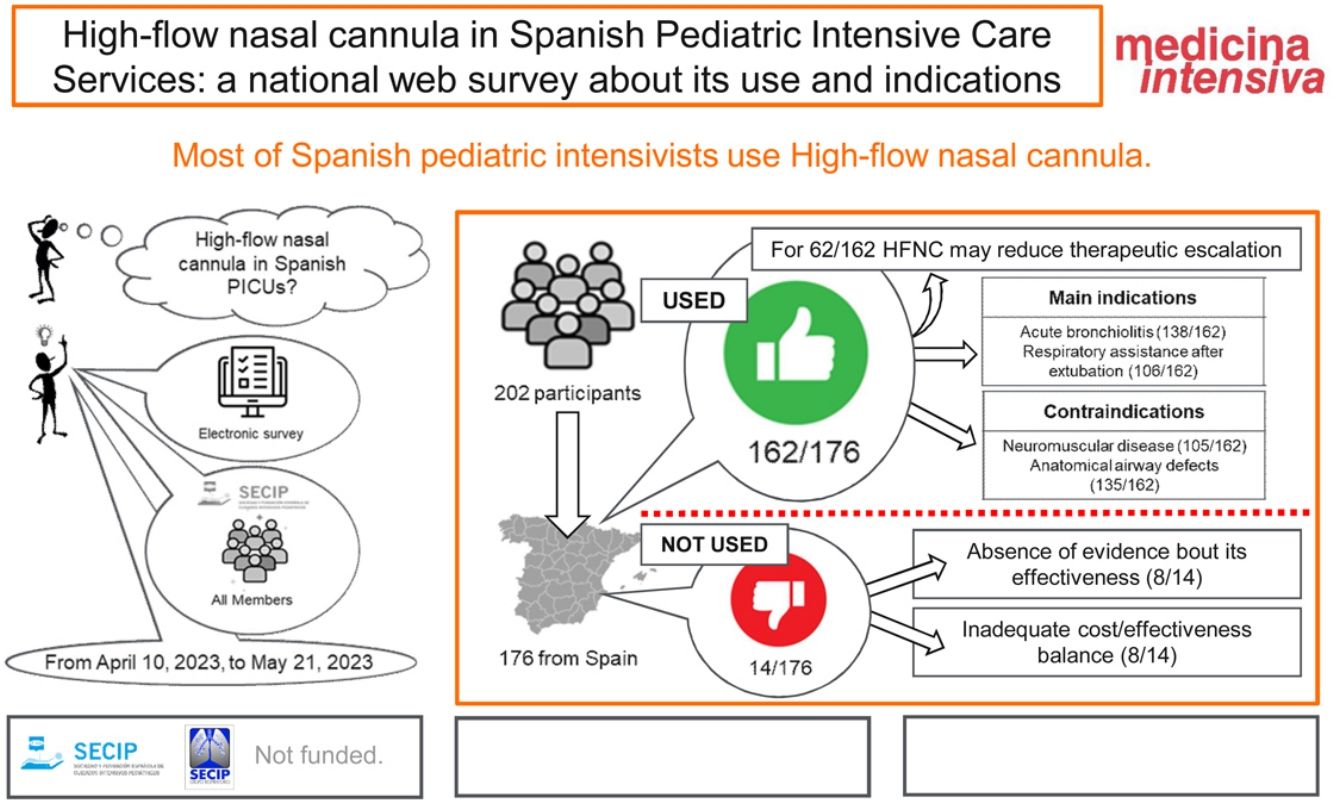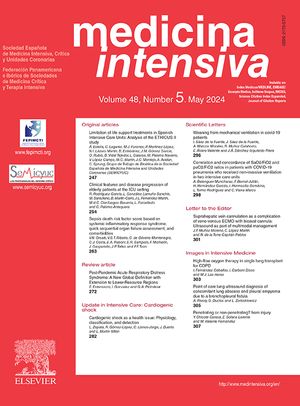To describe the high-flow nasal cannula (HFNC) indications in the Spanish pediatric critical care units (PICUs).
DesignDescriptive cross-sectional observational study.
SettingElectronic survey among members of the Spanish Society of Pediatric Intensive Care (SECIP). It was sent weekly from April 10, 2023, to May 21, 2023.
ParticipantsAll SECIP members.
InterventionsNone.
Main variables of interestThe questions focused on workplace, years of experience, use or non-use of HFNC, justification and expectations regarding its application, starting point within each center, clinical criteria for indication, existence of clinical guidelines, evaluation during its use, and criteria and mode of withdrawal.
ResultsTwo hundred and two participants, 176 were from Spain. Of these, 87/176 had over ten years of experience. One hundred sixty two use HFNC and 66/162 have HFNC clinical guidelines. Acute bronchiolitis (138/162) and respiratory assistance after extubation (106/56) are the two main indications. For 62/162 HFNC may reduce therapeutic escalation. Neuromuscular diseases (105/162) and anatomical airway diseases (135/162) are the two main contraindications. The reasons to do not use HFNC were the absence of evidence about it effectiveness (8/14) and its inadequate cost/effectiveness balance (8/14).
ConclusionsA majority of Spanish pediatric intensivists use HFNC. Its application and withdrawal appears to be primarily based on clinical experience. Besides, those who use HFNC are aware of its limitations and the lack of evidence in some cases. It is necessary to develop single-center and multicenter studies to elucidate the effectiveness of this therapy in the context of critically ill children.
Describir las indicaciones de las cánulas nasales de alto flujo (CNAF) en las unidades de cuidados intensivos pediátricos (UCIP) españolas.
DiseñoEstudio observacional descriptivo transversal.
ÁmbitoEncuesta electrónica a miembros de la Sociedad Española de Cuidados Intensivos Pediátricos (SECIP). Se envió semanalmente desde el 10 de abril de 2023 hasta el 21 de mayo de 2023.
ParticipantesMiembros de la SECIP.
IntervencionesNinguna.
Variables de interésprincipalesLas preguntas se centraron en lugar de trabajo, años de experiencia, uso o no de la CNAF, justificación y expectativas respecto a su aplicación, criterios clínicos de indicación, existencia de guías clínicas, la evaluación durante su uso y los criterios de retirada.
ResultadosDoscientos dos participantes, 176 españoles. De ellos, 87/176 con más de diez años de experiencia. Ciento sesenta y dos usan CNAF y 66/162 tienen guías clínicas. La bronquiolitis aguda (138/162) y la asistencia respiratoria tras la extubación (106/56) son las indicaciones principales. Para 62/162 la CNAF puede reducir la escalada terapéutica. Las enfermedades neuromusculares (105/162) y las alteraciones anatómicas de la vía aérea (135/162) son las principales contraindicaciones. Las razones para no utilizar la CNAF fueron ausencia de evidencia sobre su efectividad (8/14) e inadecuado balance costo/efectividad (8/14).
ConclusionesLa mayoría de los intensivistas pediátricos españoles utilizan CNAF. Su aplicación parece basarse en la experiencia clínica. Además, quienes utilizan CNAF son conscientes de sus limitaciones y de la falta de evidencia en algunos casos. Es necesario desarrollar estudios unicéntricos y multicéntricos para dilucidar la efectividad de esta terapia en el niño críticamente enfermos.
Article
Go to the members area of the website of the SEMICYUC (www.semicyuc.org )and click the link to the magazine.


















